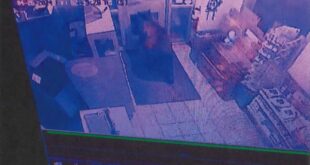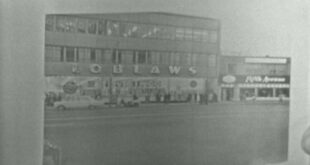Vacant buildings account for about 15 per cent of major fires in Montreal.
Just before dawn on March 23 as an early spring snowstorm blanketed the city, an old greystone building on St-Dominique Street began to burn.
Investigators don’t yet know what caused the fire, but it was cold that night and squatters had been known to use the building, which had been boarded up for nearly two decades.
Samuel Lu, a neighbour, recalled waking up that morning to noise and chaos. He saw the flames consuming the building and dozens of firefighters battling the blaze.
“It was scary,” said Lu, who had to quickly usher his seven-year-old daughter and elderly father to safety. “It was surreal.”
Though Lu said it was shocking to see the building burn and then collapse into rubble, it was not a surprise. The building was not well maintained, said Lu, who frequently noticed trespassers on the building’s fire escape and roof.
The fire at the building on St-Dominique Street is part of a larger problem in Montreal.
Around 800 buildings sit derelict across the city, municipal officials estimate. A CBC News analysis found these buildings are at greater risk of catching fire, posing a danger to firefighters and threatening the city’s built heritage.
Despite ongoing efforts by the city to force building owners to take better care of vacant properties, these buildings continue to burn.
In the past five weeks alone, three vacant buildings caught fire in Montreal. One of them was an abandoned school. The other two, the building on St-Dominique Street and a building at the corner of Parc Avenue and Sherbrooke Street, were among some of the city’s oldest.

Their destruction concerns advocates who fear fire and neglect have replaced demolition as the most pressing threat to Montreal’s heritage.
“These buildings have value individually,” said Dinu Bumbaru, the policy director for Heritage Montreal, “but they also shape the city in terms of neighbourhood views. They shape the cityscape.”
Last fall, the City of Montreal passed a bylaw aimed at improving the upkeep of vacant buildings.

Why are Montreal’s vacant buildings more likely to burn down?
City officials estimate about 800 buildings sit derelict across the island. According to data obtained by CBC, these are most susceptible to fire and older buildings are also at greater risk.
The new rules require property owners to maintain a minimum temperature of 10 C inside their buildings and secure entry points. Owners who do not comply will be subject to fines that could climb as high as $250,000 for neglectful heritage building owners.
They’ll also have to register their vacant buildings with the city every year.
But progress on the city’s registry, which is supposed to come together this year, is going “slow,” according to Ericka Alneus, who sits on the city’s executive committee and is responsible for heritage.
Alneus said the bylaw, and the registry, once established, will send a clear message to property owners: “You have to be responsible for your vacant building and that you have to be accountable for the effect of the fact that this building is not being taken care of properly.”
As the city compiles its registry of vacant buildings, they continue to be a fire risk.
In addition to the three recent vacant buildings that caught fire in Montreal, data obtained by CBC News shows that 11 of the 80 serious fires (between three- and five-alarm) in greater Montreal between 2020 and the end of 2023 were in vacant buildings.
That means vacant buildings are burning at higher rates than non-vacant buildings.
Chris Ross, the president of the Montreal Firefighters Association, said vacant buildings tend to be old, made of wood and built according to antiquated fire codes, all of which make them more susceptible to fire.
Older buildings are at greater risk of fire. The data obtained by CBC News showed more than half of major fires in Montreal from 2020 to the end of 2023 occurred in buildings constructed before 1945.
“You’re not going to have an automatic sprinkler system, you’re not going to have a fire alarm,” Ross said of those buildings.
Vacant, abandoned buildings pose a unique challenge to firefighters. Age and neglect weaken floors and staircases, changing the way firefighters approach them.
“Vacant buildings and large fires are firefighter killers,” said Ross. “If you remove cancer and you remove cardiac arrest at a fire, one of the number-one killers of firefighters is premature building collapse.”
To mitigate risk, the fire department keeps a list of vacant buildings. But it’s not perfect.
The fire department did not immediately realize the Sherbrooke Street building which recently burned was vacant, although the building behind it, which is owned by the same developer, was on the firefighters’ list, said Ross.
Ross thinks the new bylaw is a positive step, but says it won’t mean much if there isn’t proper enforcement.
“It requires the adequate personnel to go out and do those verifications,” said Ross.
Alneus, the city councillor, insisted there are enough inspectors.
Bumbaru, the heritage advocate, identified two main culprits for why vacant buildings sit abandoned. Slow-moving city processes are sometimes to blame, he said. The building at the corner of Parc and Sherbrooke was an example of this.
A developer wanted to build on the land and had proposed a structure that incorporated the building’s historic facade, but, awaiting various approvals, the project lagged and the building was still vacant when it caught fire on March 20. CBC News reached out to the developer but didn’t hear back.
Bumbaru also said building owners sometimes neglect their properties ostensibly for personal gain, waiting to receive a lucrative offer from a developer.
He thinks the city should audit heritage buildings to evaluate their fire risk. That way, the city can step in sooner if there’s a problem.
Meanwhile, a pile of charred rubble is all that remains of the building on St-Dominique Street. It’s the owner’s responsibility, but most of it is piled on Lu’s property, a reminder of the decrepit building and the night it burned.
“I look out the door,” he said, “and I say, ‘Wow. When can we move forward? When can we clean this up? When can we have our lives back?'”
While CBC News was speaking to Lu, a worker from a demolition company showed up to do a site survey. Clearing the debris could be an expensive job, demolitions of this type frequently cost hundreds of thousands of dollars.
Arvind Soni, the owner of the greystone on St-Dominique Street, declined to answer any questions about the building when reached by phone and hung up on CBC News.
“I have no answers for you,” he said.
ABOUT THE AUTHOR
Leah Hendry is an investigative reporter with CBC in Montreal. She specializes in health and social issues. She has previously worked as a reporter for CBC in Vancouver and Winnipeg. You can email story ideas or tips to montrealinvestigates@cbc.ca.
*****
Credit belongs to : www.cbc.ca
 Atin Ito First Filipino Community Newspaper in Ontario
Atin Ito First Filipino Community Newspaper in Ontario






